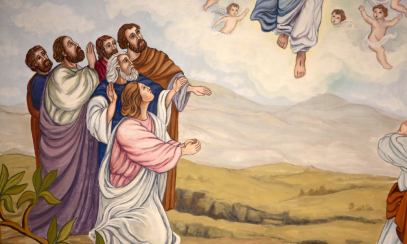
Liturgy: Part 7
What is the Liturgy? An Exploration of the Church’s Public Prayer.
What is the Liturgy? An Exploration of the Church’s Public Prayer.
The death of someone we love is one of life’s most heart-rending moments. We are often numb with shock and filled with grief. The Catholic Church’s funeral liturgies offer mourners consolation, hope and faith in the resurrection. They usually occur in three parts: the vigil, the Mass of Christian Burial, and the rite of committal or graveside service.
The vigil takes place for one or more days prior to the funeral. It used to be the custom for the vigil, or wake, to be held in the home of the deceased. Now, it is more customarily held in a funeral home. Recently, there has also been a growing trend to celebrate the vigil in the parish church or hall – it is very moving to receive the condolences of friends and family in the presence of the Blessed Sacrament and in a place where the deceased person worshipped in community. It is common for the evenings of the wake to close with the recitation of the rosary or a Scripture service. The vigil is also the most appropriate place for eulogies, in which stories and memories of the dead person are shared.
The Mass of Christian Burial is the fulcrum of the funeral liturgies. At the beginning of the Mass, the priest welcomes the body at the entrance to the church. Family members place a white pall over the casket, representing the white garment in which the person was clothed at his or her baptism. The body is carried to the front of the church, where members of the family place a crucifix and a Bible on it, symbolizing the person’s Christian faith.
Changes in the funeral rites since Vatican II mean that we focus on the joy of resurrection rather than the sorrow of loss. The vestments are white, symbolizing joy, rather than their former black. The emphasis is on eternity, not on our present grief.
The Liturgy of the Word comprises readings chosen by the family – they are selected for their consolation and hope of eternal life. The priest or deacon preaches on the readings – offering a homily, not a eulogy.
The Liturgy of the Eucharist follows, reminding us of Christ’s passion, death and resurrection. We are offered the hope of eternal life – for our loved one and for ourselves. Members of the family may serve as extraordinary ministers of Communion, readers and altar servers. After Communion, a friend or family member may be invited to share a brief reflection on the life of the departed.
There is a final procession to the place of committal, the cemetery. At the graveside, the priest or deacon offers a final commendation and prayers of farewell are said. If there has not been a eulogy, one may be offered at this point.
Occasionally, the family may have chosen to cremate the body. The Catholic Church permits cremation and, since 1997, it has been permissible in the United States to have the cremated remains present for a funeral liturgy. Afterward, the remains should be treated with the same respect as a body would be – not kept in the home, but interred in a cemetery or entombed in a columbarium.
The Catholic celebration of a person’s life, coupled with the community’s consolation to that person’s loved ones, is one of the most profound ways the church acts as Christ in the world.
Who’s in the sanctuary?
Cantor: The cantor is the liturgy’s chief singer. In monastic choirs, this was an office of high honor and the cantor often carried a staff to indicate rank. The cantor leads the congregation in song, frequently proclaiming the verses of the responsorial psalm. You may see the cantor move to the ambo for the proclamation of this psalm.
Why do we do that?
Singing:
“Make a joyful noise unto the Lord!” You’ll notice that the Scripture mentions joy, not pitch or key. Singing is an important part of worship and some elements of the Mass are specifically designed to be sung. Examples are the Sanctus (“Holy, holy, holy” prayer) and the great Amen. Singing is a wonderful way for a congregation to express unity, since they are singing the same words at the same time and in approximately the same tone. The General Instruction of the Roman Missal (GIRM) extols the importance of congregational singing and stresses its necessity at Sunday and holy day Masses. Everyone present is urged to sing out with great joy, not just those who can carry a tune!
What’s he wearing?
Pectoral Cross:
The bishop wears a cross called a pectoral cross. Its name derives from the Latin word pectus or “breast.” There are rules that dictate how the cross is worn depending on the bishop’s garments. If he’s in a suit and collar, the pectoral cross is usually placed in the vest pocket with the chain showing – that’s why you’ll often see the bishop with a gold chain across his chest.
What’s in the church?
Sacred vessels:
The chalice is the cup in which the wine that becomes the blood of Christ is contained. The ciborium is the container for the hosts that will be consecrated at Mass and reserved in the tabernacle – it may be shaped somewhat like the chalice, but has a fitted lid. In medieval times, the word ciborium also referred to a canopy over the tabernacle, but that is no longer the case. The pyx is a small container that holds a few consecrated hosts – extraordinary ministers of holy Communion use a pyx to take Communion to the sick and homebound. All of these vessels are to be made of a material of value that is not easily broken. They should be treated with reverence due to their sacred functions.
What’s the season?
Holy Days of Obligation:
There are various feasts throughout the church year that are so important they have been designated as holy days of obligation, on which the faithful must attend Mass. Each country has its own list of holy days – in most dioceses of the United States, they are Jan. 1, the Solemnity of Mary; Aug. 15, the Solemnity of the Assumption; Nov. 1, the Solemnity of All Saints; Dec. 8, the Solemnity of Immaculate Conception; and Dec. 25, the Solemnity of Christmas. If Jan. 1, Aug. 15, or Nov. 1 fall on a Saturday or Monday, the obligation to attend Mass is normally dispensed.



